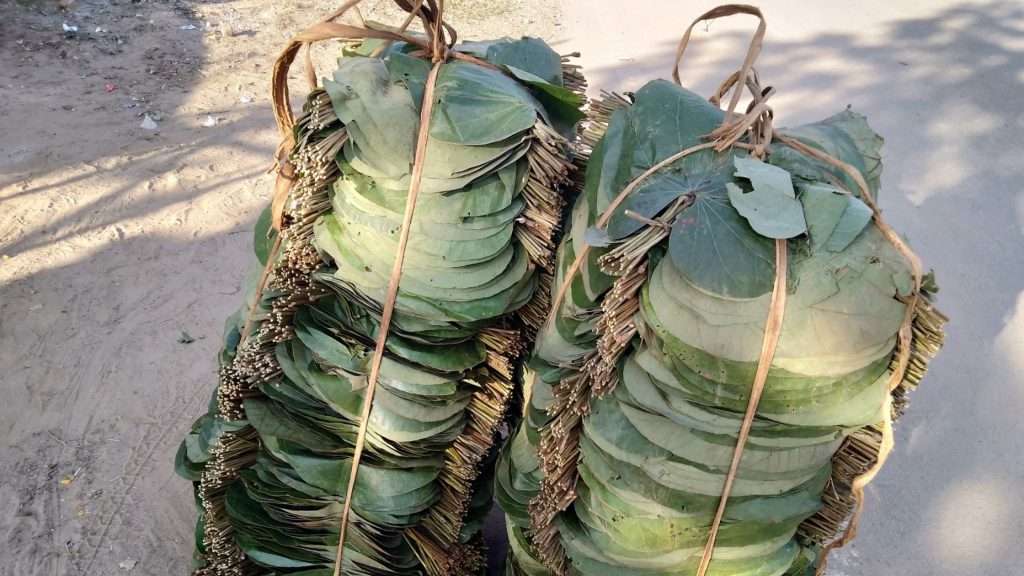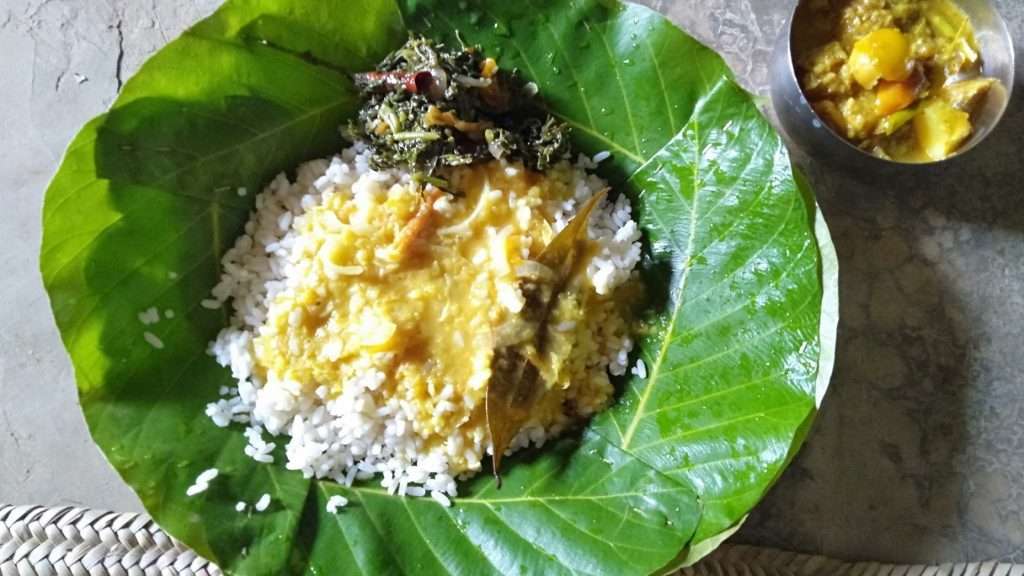In parts of Odisha, Chhattisgarh, Jharkhand and Maharashtra, the predominant source of leaf plates and containers are Sal (Shorea robusta), a tree and Siali (Bauhinia vahlii), a vine with big leaves. These two are found in the deciduous forests of the region and form an important source of income for the tribals, especially women, who engage in the manufacture of such leaf plates/containers. While the wood as well as seeds of sal have commercial values, the seeds of sal are also consumed and from an important source of nutrition during winter months for the tribal populations. At times, the twigs of sal trees are also used as tooth brushes. The various economic benefits of these two species not being overlooked, the emphasis on propagation maintenance and protection of these in the hinterlands as sources of leaf plates is essential.
Plantations of Sal Tree
Plantations of Sal and Siali saplings can also be undertaken under the afforestation schemes and programmes of the Government, public sector and private companies in the watershed of the mining areas. These would also ensure gainful employment to local tribal population. It is in the interest of both the environment as well as local population to consume these products instead of plastic alternatives that may look lucrative and easy in terms of utilization but have long term negative implications for economic sustainability and environment. Overlooking these as inconvenience not only jeopardizes the new age mantra of “Made in India” but unequivocally renders the efforts of developing local enterprises based on Minor Forest Produce (MFPs) ineffective. If forests do not supply products for consumption in a sustainable manner and do not employ the forest dwellers in an economically sustainable manner, no amount of forest rights will ever empower these populations.
Also read:
- Palua (Arrowroot) – A Wild Edible Tuber In Tribal Hinterlands
- Vanishing Grasslands: The basis of Rural Livelihoods and Sustainability
- Quails [Endangered Species]: A Source of Livelihood for Rural India
- Top 10 Health Benefits of Rose Tea
Sal leaf is a major source of income for forest dwellers in Orissa, especially in the districts of Mayurbhanj, Keonjhar, Kandhamal, Nabarangpur and Nayagarh. Primary level processing like cup and plate making provides livelihood security to hundreds and thousands of forest dwellers. It is believed in some quarters that commercial exploitation and unsustainable methods employed in collection of Sal leaves have largely been responsible for gradual but consistent depletion of Sal forests in Odisha.
Sal leaf plate, Nabarangpur

Sal leaf collection and stitching of leaf plates and cups (locally known as Khalli” and “donna”) are the major income-generating means of tribal women. Contributing to the family income, these women visit the forest in the morning and come back by afternoon, collecting around 500-1,000 leaves per day that are enough to make 150-250 plates. Collected twice a year (November-March and June-July), collection in the first phase is said to be of better quality than the second which usually gets infested by fungus. Along with women, children too collect the leaves, make plates and cups and sell them in the local market at `20-25 for one ‘chekki’ (a packet of 25 Sal leaf plates). The business usually picks up during November-December but the ongoing pandemic and subsequent lockdown have stopped all means of business for these sal leaf collectors, who now find no takers for their products. Add to it the curbs on marriages and festivals, shut down of weekly markets, hotels and dhabas, which have shrunk the demand for the biodegradable leaf plates. The used leaves/plates are readily eaten by goats and cattle.
Even around a decade ago, wedding feasts in Odisha would be incomplete without palatable homely meals, graciously served in beautiful sal leaf plates, locally termed as ‘Khalli’. The khallis would mostly be accompanied by clay water glasses and bowls. The natural aroma of dried or fresh green sal leaves would only accentuate the taste of the food served in it. Fascinatingly, not a shred of plastic or any non-biodegradable waste would be left behind, no matter how grand a feast was. However, the scenario changed almost overnight with the advent of disposable, single-use plastic cutlery. From urban settlements, the trend penetrated the rural interiors. Earlier, the amount earned from the sales was enough to sustain the collectors for about six months. But the lockdown has left them in a quandary. With the hope of selling the products after things normalise, many women have stacked these leaves in their houses. Despite machine-made leaf plates being introduced in the markets, demand for Sal leaf products was not hampered in the pre-pandemic times.
Local traders procure the sal leaf plates from the local communities and send them to Cuttack, Bhubaneswar, Berhampur and neighbouring Andhra Pradesh. But with restrictions on inter-State vehicular movement and lockdowns, traders were unable to visit the villages. Sal leaf plates took a backseat in the village homes as plastic was cheaper and easier to avail. Soon, heaps of discarded plastic plates, bowls and cups were an eyesore in picturesque hamlets. However, this affected the forest-dependent tribal communities of Keonjhar – the district well known for its widespread sal forests. The livelihoods of these indigenous inhabitants solely comprised of making plates and cups made from sal leaves. Thousands were rendered jobless and were forced to give up their ancestral vocation.

The village’s women sometimes get together to knead a mixture of ant-hill clay, cow dung and cow urine into egg-shaped balls. The dried balls will be broken open during the Swan Ucchab (the bathing festival) of the Lord Jagannath and seeds of Siali (Bauhinia vahlii), preserved inside them, taken out. The women might not be aware of the ecological jargon ascribed to this activity. But environmentalists say this is an organic method to preserve biodiversity. On the Snan Puja day the seeds are sown and prayers offered for the healthy growth of siali climbers. The colorful ritual has a significance which extends far beyond annual festivities. Siali and sal (Shorea robusta) leaves are the major source of sustenance for people in the predominantly tribal districts of eastern Orissa.
Marginalized forest dwellers of Kalahandi-Balangir-Koraput (KBK) region, especially women, who depend on minor forest produce like sal leaf for a living, have been badly affected during the pandemic. With limited access to markets and traders unable to procure the product due to lockdown restrictions, these women are battling livelihood issues with no income over the past few months. For tribal women in Mayurbhanj collection and selling of Sal leaf cup and plates, though not remunerative and commensurate with labour, is a major source of income. She along with her family members spends more than 12 hours (6 in the morning to 6 in the evening) a day to collect one bag of Sal leaves that invariably contains 1000 – 1200 leaves. On the second day, they stitch the leaves and make plates and pali (pali is two leaves stitched and later on compressed to chautis or cups). About 6-7 leaves are required to stitch one plate that means that about 200 plates are stitched from one day’s collection. On the third day, the plates are dried and made ready for binding and sale. Three days of hard labour fetches the entire family a mere sum of 10-12 rupees, provided the Government declared rates (Rs 5/- per one chaki of 80 plates) are given. Interestingly, the Government rates are fixed for 80 plates but traders collect 100 plates for the same price.
Trade in these leaves has saved people in Mayurbhanj district from starvation deaths. At dawn women set out for the forests. They are there till afternoon, carefully selecting leaves that would be stitched the next day to make plates. A day’s collection usually comes to 1,000-1,200 leaves, enough to make 150-200 plates. The plates are dried the next day, by which time traders’ agents are at the collectors’ doorsteps. People in Mayurbhanj sell 1000 sal leaf plates for INR 300 to INR 350 to the trader’s agent, who comes to collect these from their village. Though the government has fixed a price – a packet of 80 plates is Rs 24, there is some haggling. Eventually, the collectors give in to the agents. The plates are carried off to Orissa’s two main centres of the leaf plate trade in Betanati in Mayurbhanj and Rupsa in Balasore. Here the business acquires a ring of secrecy. Truckers transporting the products to retail markets in different parts of the country are likely to give you a fierce glare if you ask them about the volumes in their charge. A similar query to a trader may elicit a spiel on falling profits.
Marketing of Sal leaf plates

A survey of price of leaf plates in the southern part of Odisha showed that both plastic plates and leaf plates cost INR one per piece in Nabarangapur, located in an area with decent amount sal forests. At another location Tikiri, located in the mining areas of Rayagada district, the cost at the site of production was only 35-40 paise when sold in bulk. The consumption is mainly by the local temple and during local cerebrations, creating an irregular demand for the product. Thus, channelizing the supply and demand would help to market this product well and create an employment opportunity for the forest dwellers. However, most of the marketing is controlled by “Middlemen” – the Kumuti community in South Odisha. They collect the leaf plates from the tribal communities from the villages in the hinterland and sell it in the urban markets. Most of the profits are taken by the middlemen with little earnings for the primary collectors and manufacturers.
Government intervention
The Government and Nationalized banks can support the tribal communities through provision of soft loans for leaf plate pressing and processing machines. The use of such machines will improve the quality of the leaf plates as per the urban consumer quality demands and can be marketed at a much remunerative price. The tribal areas have a positive side in that many places still have a healthy female to male ratio and by tradition, women are involved in both the social and economic activities of the household. Leaf plate manufacturing is a time consuming activity but requires less physical labor, suitable for women compared to others more rigorous activities of the agro-forestry system. In effect it can help to provide economic engagement for women with children or in family way who are restricted within four walls.
A visit to the local market in the town of Nabarangapur, which traditionally sees both buyers and sellers of leaf plates actively engaged throughout the year in transactions showed that leaf plates are not being sold as a product in demand as earlier. Both the cost as well as the ability to procure, store and utilize leaf plates seems less attractive to the urban dwellers. However, the urban dwellers need to be alerted about the plastic pollution in their neighborhood as well the possible consequences of consuming toxic plastic components indirectly and in a cumulative manner to help them understand the benefits of leaf plates. Leaf plates when disposed will ultimately help to add organic matter to the soil enriching it further while plastic will only add to misery of the soil systems.
Rapid deforestation for mining, roads, real estate, industries well as a low demand have resulted in a low interest in production of leaf plates among tribal population. An area that witnesses heavy migration of rural population and laborers has an importance source of economic sustenance in the form of such leaf plates. It would not only help engage the male population in collection but also help women who stay back and can earn extra remuneration during seasons when active field labor is unavailable. Efforts to help in increasing the cover under these species require out of the box thinking among local authorities entrusted with the responsibility of clearing forests for other economic activities. Similarly limiting economic activity inside forests where these sources of leaf plates exists can help protect the source of raw materials. The importance of these species to provide employment and economic support to large number of people as opposed to plantations where a few benefit can be driven home to gram panchayats.
The trade is unorganized, but according to conservative estimates, Orissa does Rs 400 crore of business in siali and sal leaves every year. Sal Leaf, a minor forest produce (MFP) that forest-dwelling communities can collect and trade, has been taxed 18 per cent. Tribal communities in Odisha whose sustenance depends on collection of Sal leaf and making plates out of them, are directly affected. According to experts working on the issue, around 1.5 million people depend on collection of Sal leaves for sustenance. Earlier, these plates were exempt from Value Added Tax or exercise tax in the state; only a royalty of Rs 72 per quintal of leaves was to be given to the forest department. This additional economic burden has invariably hurt the trade of Sal leaf plates. While the tax has to be paid by the trader, the traders, to cut cost, have been transferring the burden of the tax to the leaf collectors. The trade of the plates, meanwhile, has gone down to the doldrums. The sale of the Sal leaf plates to traders has many challenges – they are reluctant to buy and cite various reason best known to them. In worst cases, they are offering low prices. The new system has four categories of taxes: 5%, 12%, 18% and 28%. Some types of MFPs, like natural honey are not taxed.

The tax levied on some MFPs is going to negatively impact tribal communities whose sustenance depends on their trade. The forest dwelling communities are given the right over MFP under section 3(1) (c) of Scheduled Tribes and Other Traditional Forest Dwellers (Recognition of Forest Rights) Act, 2006 (FRA). The forest right act also clearly states that there will be no tax/royalty on MFPs. As millions of people predominantly tribal in India depending on forest and forest produce for their livelihood, taxes under GST would essentially push them into poverty. The traders say profits have fallen since when the government imposed a royalty of Rs 60 per 100 kg on sal leaves, there is however no royalty on the siali leaf trade. But market observers say traders have passed on the burden to the primary collectors. Orissa government officials are, however, dead sure of the fairness of the business. The prices are fixed by the state government and traders cannot cheat the collectors. However, a large number of families are dependent on leaf collection not having enough options but to keep prices low. Storage facilities will be helpful but there are none. Transportation costs are high. It is beyond the means of the primary collectors to take their produce to the wholesale market. Traders take advantage of this.
Some environmentalists allege that with the increasing demands on the collectors, many of them have taken to ways that harm the trees. Things were fine till leaf collection was confined to hamlets within or close to the forests. But now collectors from far off villages come for sal and siali leaves. Many aren’t that careful. Some environmentalists allege that branches are wrenched out, causing irreparable damage to trees. However, many activists refute these arguments. People do take good care of the trees since these are critical to their livelihoods. Besides, the government allows collection of leaves for only four to six months, allowing the trees sufficient time to regenerate. Environmentalists, however, say that there is no scientific basis to this government moratorium.
There has been an increasing awareness of the health benefits of consuming food from leaf plates as compared to plastic in the western world. Urban dependency on rural resources is often based on the awareness among urbanites about health benefits of consumption of items procured from rural areas as opposed to imported stuff. A sal leaf plate costs anywhere in the range of INR 4 to INR 8 per plate. Therefore, while addressing the issues of increasing the production of leaf plates, it would be also wise to create a sustained market demand among urban population for the same.
About the Author:
Mr. Ravi Shankar Behera, PGDAEM, National Institute of Agricultural Extension Management (MANAGE), Hyderabad is an independent freelance Consultant and Author based in Bhubaneswar. He is an Honorary Advisor to grassroots Voluntary Organizations on Food Security, Forest and Environment, Natural Resource Management, Climate Change and Social Development issues. Ravi has lived and worked in various states of India and was associated with international donors and NGOs over the last twenty three years including ActionAid, DanChurchAid, Embassy of Sweden/Sida, Aide et Action, Sightsavers, UNICEF, Agragamee, DAPTA and Practical Action. He has a keen interest in indigenous communities and food policy issues.
Dr. Ranjit K. Sahu is an American laboratory and research specialist located in Virginia, USA. Dr. Ranjit is a freelance writer, artist, poet, and story writer. He has over 18 years of experience in Biotechnology and biomedical research. His interests include education, environment, sustainability, and health care systems and practices in the underprivileged regions of the world.


